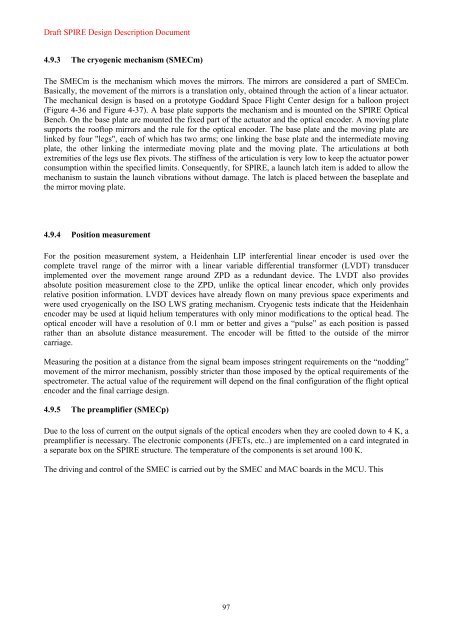SPIRE Design Description - Research Services
SPIRE Design Description - Research Services
SPIRE Design Description - Research Services
Create successful ePaper yourself
Turn your PDF publications into a flip-book with our unique Google optimized e-Paper software.
Draft <strong>SPIRE</strong> <strong>Design</strong> <strong>Description</strong> Document<br />
4.9.3 The cryogenic mechanism (SMECm)<br />
The SMECm is the mechanism which moves the mirrors. The mirrors are considered a part of SMECm.<br />
Basically, the movement of the mirrors is a translation only, obtained through the action of a linear actuator.<br />
The mechanical design is based on a prototype Goddard Space Flight Center design for a balloon project<br />
(Figure 4-36 and Figure 4-37). A base plate supports the mechanism and is mounted on the <strong>SPIRE</strong> Optical<br />
Bench. On the base plate are mounted the fixed part of the actuator and the optical encoder. A moving plate<br />
supports the rooftop mirrors and the rule for the optical encoder. The base plate and the moving plate are<br />
linked by four "legs", each of which has two arms; one linking the base plate and the intermediate moving<br />
plate, the other linking the intermediate moving plate and the moving plate. The articulations at both<br />
extremities of the legs use flex pivots. The stiffness of the articulation is very low to keep the actuator power<br />
consumption within the specified limits. Consequently, for <strong>SPIRE</strong>, a launch latch item is added to allow the<br />
mechanism to sustain the launch vibrations without damage. The latch is placed between the baseplate and<br />
the mirror moving plate.<br />
4.9.4 Position measurement<br />
For the position measurement system, a Heidenhain LIP interferential linear encoder is used over the<br />
complete travel range of the mirror with a linear variable differential transformer (LVDT) transducer<br />
implemented over the movement range around ZPD as a redundant device. The LVDT also provides<br />
absolute position measurement close to the ZPD, unlike the optical linear encoder, which only provides<br />
relative position information. LVDT devices have already flown on many previous space experiments and<br />
were used cryogenically on the ISO LWS grating mechanism. Cryogenic tests indicate that the Heidenhain<br />
encoder may be used at liquid helium temperatures with only minor modifications to the optical head. The<br />
optical encoder will have a resolution of 0.1 mm or better and gives a “pulse” as each position is passed<br />
rather than an absolute distance measurement. The encoder will be fitted to the outside of the mirror<br />
carriage.<br />
Measuring the position at a distance from the signal beam imposes stringent requirements on the “nodding”<br />
movement of the mirror mechanism, possibly stricter than those imposed by the optical requirements of the<br />
spectrometer. The actual value of the requirement will depend on the final configuration of the flight optical<br />
encoder and the final carriage design.<br />
4.9.5 The preamplifier (SMECp)<br />
Due to the loss of current on the output signals of the optical encoders when they are cooled down to 4 K, a<br />
preamplifier is necessary. The electronic components (JFETs, etc..) are implemented on a card integrated in<br />
a separate box on the <strong>SPIRE</strong> structure. The temperature of the components is set around 100 K.<br />
The driving and control of the SMEC is carried out by the SMEC and MAC boards in the MCU. This<br />
97
















